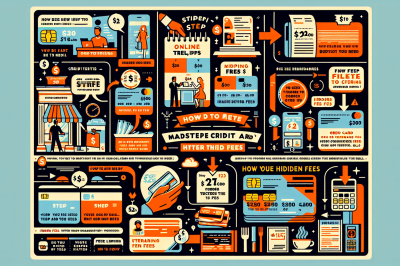Credit cards are powerful financial tools that offer convenience, rewards, and the capacity to build credit. However, they can also be a source of unexpected costs if not managed properly. Hidden fees, often buried in the fine print of credit card agreements, can surprise even the most savvy users. Mastering the use of your credit card involves more than just responsible spending; it requires a thorough understanding of your card’s fee structure and knowing how to avoid unnecessary charges. This article explores the essential strategies and insights needed to navigate credit card fees effectively, ensuring you maximize the benefits while minimizing the costs.
Understanding Credit Card Fee Structures
Credit card companies make a substantial amount of revenue from fees, and these can vary significantly between cards and issuers. The most common fees include annual fees, balance transfer fees, late payment fees, and foreign transaction fees. Each credit card issuer provides a Terms and Conditions document when issuing a card, which includes a section dedicated to fees. It’s crucial to read and understand this part of your credit card agreement to avoid surprises. For instance, some cards charge a flat rate annually, while others may waive the annual fee if a certain spending threshold is met.
Understanding fee structures also means being aware of less obvious charges such as cash advance fees, payment protection insurance, and fees for exceeding your credit limit. Cash advances often carry higher interest rates in addition to the fees. Payment protection insurance might be automatically added to your account, so it is important to verify whether this service is actually needed based on your financial situation. Over-limit fees can catch you off guard if you’re not monitoring your spending closely, which underscores the importance of keeping track of your account balances and setting up alerts.
Moreover, some credit cards have variable fee structures based on the cardholder’s creditworthiness or spending patterns. For example, a card may have different levels of rewards and corresponding fees, or offer a lower interest rate to users who maintain a high credit score. Seasonal promotions and changes to credit card laws can also affect fee structures, making it imperative to stay informed about any announcements from your credit card issuer. Regular review of your credit card statements and terms is essential to catching any adjustments that may impact your costs.
Strategies to Evade Unnecessary Charges
One effective strategy to avoid unnecessary credit card fees is to choose cards that match your spending habits and financial situation. For instance, if you travel internationally regularly, a card that offers zero foreign transaction fees would be ideal. Similarly, if you tend to carry a balance, looking for a card with a low interest rate and no annual fee might make more financial sense. It’s also beneficial to use cards strategically; for example, using a specific card for dining out if it offers higher cash back percentages in that category.
Setting up automatic payments can prevent late fees and possible damage to your credit score. Most credit card issuers allow cardholders to set up an auto-pay feature that can be configured to pay the minimum payment, a fixed amount, or the full statement balance each month. This not only helps in managing payments but also ensures that you never miss a payment deadline. Additionally, configuring alerts for due dates, credit limits, and large transactions can keep you aware and in control of your account activity, thus avoiding fees related to over-limit charges or fraud.
Lastly, regularly communicating with your credit card issuer can lead to waiving certain fees. For example, if you were charged a late fee due to an oversight but generally have a good payment history, a simple call to customer service might result in the fee being reversed. Furthermore, as a long-term strategy, regularly reviewing your credit card features and negotiating with your bank for better terms can reduce costs. This might include requesting a lower interest rate, having an annual fee waived, or upgrading to a better rewards program without additional costs.
Mastering the use of credit cards is not only about managing spending but also about understanding and navigating the complex landscape of fees that accompany them. By thoroughly understanding the fee structures and employing strategic measures to avoid unnecessary charges, you can maximize the benefits of your credit cards while keeping costs under control. Remember, credit cards should work for you, not against you. Make sure to stay proactive in managing your accounts, educating yourself about any changes, and optimizing the use of your cards to align with your financial goals. With the right approach, you can enjoy the convenience and rewards of your credit cards without falling prey to the hidden costs.
